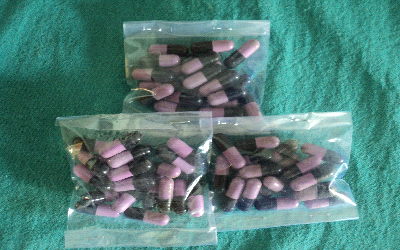ISSN 0976 - 0075
Last century in the history of human being witnessed really rapid development in every sphere of life. Tremendous advancements in technology led us to better understanding of all fields of science including medicine.With the help of an encapsulated miniature video camera entire G.I. tract can be video graphed.With the aid of telemedicine and teleconferences a patient far away from a specialist surgeon can be operated upon.But every coin has two sides.The same technology made us realize that there is another darkerside too.In modern science, kidney stone is removed by open surgery. Open surgery is very painful; especially post-surgery. It requires longer hospitalization, pain, post-operative complication, injury to vital organ, reoccurrences of the stone and also economical expenses.Mushkadi Kshara is an Ayurvedic formulation which contains purified extracts of multiple herbs. It will promote the expulsion of stone by its Mootral and Bhedana properties. It is a non-surgical procedure, easy to consumption with breaking of pathology which is beneficial to prevent reoccurrences and minimum expenditure. Hence it can be proved as most affordable and convenient non surgical treatment modalities in the developing countries which can provide relevant treatment modalities in health science. Mushkadi Kshara will be taken in capsule form because Kshara having Bitter and salty taste so it will be unpleasant for the patients in the form of churna .Kshara is Hygroscopic in nature so will be kept in air-tight container to prevent its Hygroscopic Properties .So present study designed entitled “Study the efficacy of Mushkadi kshara in the management of Mutrashmari w.s.r to Renal stone. “The present study designed as prospective randomized control single blind clinical trial.60 patients of Mutrashmari will be selected & randomly categorized in to 2 groups, each of comprising 30 Patients.and following hypothesis should be considered.Mushkadi kshara acts as a Mootrala&Bhedana properties in management of Mutrashmari.w.s.r.to Renal Stone.Result of present study shows significant results in Mutrashmari to cure as well as prevent reoccurences of the condition.
Introduction
Ayurveda, the ancient science of life is one of the pride and wealth of India. It dealt with many dreaded disease of Mutravahasrotas.Acharya sushruta, the pioneer in the art and science of surgery has described widely and comprehensively about Ashmarialong with its classification, symptomatology, etiology, pathology, complications and its management. This is the proof for the depth of knowledge of theAcharya on the subject of urinary disorders as a whole.Acharya sushruta has described purvarupa of Ashmari as pain at urinary bladder, testicles ,penis ,internal urethral orifice, Anorexia,difficulty in urination, urine smell like goat, and fever.
Ashmariis one of the most common disorder of the Mutravahasrotas. This disease is dreadful and hence considered one of the ‘Mahagadas’ by Sushruta owing to disturb the anatomy and physiology of urinary system .That means it is very difficult to cure this diseases.Sushruta explained surgery as the last choice of treatment, if it is not curable. According to him, Death is confirmatory and even after surgery. It is not sure that the disease is 100% curable.so it is better to go through the medicinal treatment rather than surgery.
Recently, the eating habits and life style of people has drastically changed from those of previous generation. Living in a busy and highly sophisticated community greatly affects habits of the people like inadequate intake of water, fast food consumption, irregular motions and inadequate urinary drainage, leads to a problem like renal stones. The others factors responsible for renal stone are high rich protein diet, Vit-A deficiency, hyperparathyroidism, infection, concentrated urine,deficiency of stone inhibiting substances like mucopolysaccharides , citrate and geographical area specially hot climate and also those having occupation of high temperature etc. However hereditary and imbalance of electrolytes such as calcium, phosphates, oxalates, magnesium also play a key role in formation of renal calculus.
In modern science there are many treatment modalities for urinary calculus like-extra corporeal shock wave lithotripsy (ESWL), Percutaneous nephro lithotomy (PCNL)[7] URS& Laser etc having their merits and demerits. But these procedures are very costly limited to urban areas only and not suitable in developing countries because above treatment not prevent reoccurrences of the stone that means above procedure not working on the pathogenesis of renal stone.
The time is ripe to expand and propagate Ayurveda, especially in the fields, where it has stronghold.there are many such areas, where Ayurveda is superior to other systems of medicine.
Ayurveda can contribute to the problematic situation where majority of the cases can be managed by medicines. The ancient classics of Ayurveda have quoted several drugs one of them is MushkadiKsharawhich will acts on renal stone by its Mootrala and Bhedana properties.
Principles of MutrashmariChikitsa stated that treatments modalities useful one after another after unsuccessful result of previous treatment modalities. According to Sushruta surgical intervention of Mutrashmarishows fatal complications and not easily acceptable by common people in the society’s. As well as surgical procedure for Mutrashmariexpect permission of superior responsible person related to the patient .That means final outcomes of surgical procedure aremostly unsuccessful and also turn in to dangerous complications including untreatable complications and death.Sushruta, thepioneer of surgery also give more emphasis on non surgical modalities in the management of Mutrashmari like Bheshja, Ghruta, Kshara, Kashaya, Kshira and Uttarbasti. Among all these modalities KsharaChikitsa is more beneficial due to its multiple properties like Mootral, Bhedana, Panchana, Tridoshghana, Anulomana, Darana, Sukshmagami, Apunarbhava and economical with easy consumption. So keeping above factors in mind we have selected the line of treatment as KsharaChikitsa entitled “Study the efficacy of Mushkadi Kshara in the management of Mutrashmariw.s.r to renal stone”.
Preparation of trial Drug
Table no.1-Mushkadi Gana-there are 12 contents mentioned by Acharya Sushruta.
|
Drug name |
Family |
Scientific name |
Rasa |
Virya |
Vipaka |
Karma |
|
Mushka |
Oleaceae |
Schrebra swietenoides |
Katu, Tikta
|
Usna |
Katu |
Mootral |
|
Palasha |
Leguminosae |
Butea monosperma |
Katu, Tikta, Kasay |
Usna |
Katu |
Mootral |
|
Dhava |
Combretaceae |
Anogeissus latifolia |
Kasay |
Sheeta |
Katu |
MutRasa ngrahaniya |
|
Chitrak |
Plumbaginaeceae |
Plumbago zeylanica |
Katu |
Usna |
Katu |
Jvaraghna |
|
Madan |
Rubiaceae |
Randia spinosa |
Tikta, Kasay ,Madhur ,Katu |
Usna |
Katu |
Vedanasthapana |
|
Kutaj |
Apocynaceae |
Halorrhena antidysenterica |
Kasaya, Tikta |
Sheeta |
Katu |
Shulahara |
|
Simsampa |
Leuminosae |
Dalbergia sisoo |
Kasaya |
Usna |
Katu |
Mootral |
|
Haritaki |
Combretaceae |
Terminalia chebula |
PanchaRasa (exept lavan) |
Usna |
Madhur |
Ashmarinahanam |
|
Bibhitaki |
Combretaceae |
Terminalia belirica |
Kasaya |
Usna |
Madhura |
Bhedana |
|
Amalaki |
Euphorbiaceae |
Emblica officinalis |
Pancaras(alavana) |
Sheeta |
Madhura |
Mootrala |
|
Arka |
Asclepiadaceae |
Calotropis procera |
Katu,tikta |
Usna |
Katu |
Bhedana |
|
Snuhi |
Euphorbiaceae |
Euphorbia neriifolia |
Katu |
Usna |
Katu |
Vednasthapana |
Mushkadi Kshara Nirman Vidhi
The stems of fully developed Muskadi yoga plants were cropped and cut them into small pieces and dried completely, and then all dried pieceswere burned and converted to ash. Then ash was collected and filtered through fine sieve. After that as per the ratio (1:6) described in Samhita the cleaned water was added in ash in a big size aluminium vessel. The mixture was stirred well and put for settle down of ash at the base of vessel.
After 24 hours the saturated water was filtered in another vessel with four fold white cotton cloth. The settle down ash at the base of container was thrown away. The process of filtration was done daily for 21 days, finally the clear liquid was obtained which was evaporated on low flame with continuous stir, and at the end of the process whitish coloured Kshara was obtained. The obtained Kshara was dried in sunlight and grinded in mixture and converted into fine powder and kept in an air tight jar.
MushakadiKshara is in crystal form having greyish to white colour. It is salty in test and is odourless; its aqueous solution yields the reaction characteristics of potassium. When exposed to the atmosphere become moist and therefore should be kept in air tight bottels.
Material and Methods
Selection of The Patients
In present study patients of Mutrashmari(renal stone) will be selected from the OPD/IPD of department of Shalya Tantra deptS.V.N.H.T.Ayurved college Rahuri, Maharashtra. An informed written consent of patient will be taken after clinical history and examination in detail with the help of research Proforma as prepared for the study.
Inclusion Criteria:
Patient willing to participate in the study.
Calculi present in kidney.
Calculi less than 10mm.
Age between 16-70 yrs.
Patient with sign and symptoms described in Granthas.
Both the sexes will be included.
Exclusion Criteria:
Age below 16 and above 70 yrs.
Calculi more than 10mm.
Stone present at the site other than the kidney
Stone in pelvic-ureter junction.
The patients suffering from systemic disease such as AIDS, Tuberculosis, Diabetes mellitus, Hepatitis-B, Malignancy, Vericose ulcer, Deep vein thrombosis, Arterial ulcer , Neurogenic ulcer, Leprosy, Pregnancy, Acute & Chronic renal failure, Jaundice & cirrhosis of liver.
Place Of Work: OPD and IPD of Shalya Tantra department, S.V.N.H.T.Ayurved college Rahuri, Maharashtra.
Consent:Informed written consent of every patient will be taken before the treatment.
Research Proforma: After registration of the patient for research study specially prepared research Performa will be fill up with respect to history, physical and clinical examination and investigation.
Intervention
Group A- (experimental group)
In this group 30 patients of Mutrashmari(renal stone) will be given capsule of Mushkadi Kshara .
Packing : 500mg in each capsule
Dose : 1gm BD After Meal
Route Of Administration : Oral
Anupan : Water
Duration Of Treatment : 30 Days
Visiting Schedule : 0, 7, 15, 30th days
Group B-(control group)
In this group 30 patients of Mutrashmari(renal stone)will be given Flavoxate 200mg OD for 30 days
After 30 days patients will be subjected for follow up to routine investigation and treatment.
Tab. Urikind 200 mg
Pharmacological name- Flavoxate
Company- Mankind Pharma
Dosages- 200mg OD after meal
Duration of treatment: 30 days
Follow up study: 0, 7th, 15th,30thdays
Pathayapathya:-Pathayapathya was given according to Ayurvedic texts and modern medical science for both groups.
Do:- patient were advised to drink 4-5 liters of water per day.
Don’t:- patient were advised to avoid tomato,cauliflower,spinach, fish,meat,during the period treatment.
Management of non responding to treatment & complications:
After complete regime of treatment the patients who will not respond to the treatment will be shifted on appropriate treatment. If any complication occurs, it will be recorded and treated by appropriately.
Laboratory Investigation
Hemoglobin percentage
Total WBC count.
Differential count.
Erythrocyte sedimentation rate
Blood sugar level.
Sr. Creatinine.
urine PH
Urine sugar.
Urine albumin.
Urine microscopic examination.
Plain X-Ray KUB.
USG For Abdomen.
Effect of Therapies
In the present study, 66 patients were registered out of which 6 patients left treatment against medical advice. Remaining of 60 patients completed the full course of the treatment. They were categorized into two groups and studied as follows ,
Mushkadi Kshara (Group – A : Experimental Group)
Table no. 2: Effect of therapy on clinical features (Acc. to Ayurveda) in 30 patients of Mutrashmari
|
|
Mean |
|
|
|
|
|
|
|
Clinical Features |
|
% |
S.D. |
S.E. |
‘t’ |
P |
|
|
B.T. |
A.T. |
||||||
|
Nabhi Vedana |
2.14 |
1.08 |
54.55 |
0.69 |
0.23 |
4.60 |
|
|
Basti Vedana |
1.37 |
0.62 |
53.85 |
0.72 |
0.36 |
2.99 |
|
|
Sevani Vedana |
1.17 |
0.60 |
45.45 |
0.63 |
0.27 |
2.54 |
|
|
Mehan Vedana |
0.80 |
0.40 |
50.00 |
0.70 |
0.22 |
1.81 |
|
|
Mutradhara Sanga |
3.5 |
1.90 |
45.71 |
0.80 |
0.25 |
6.40 |
|
|
Sarudhira Mutrata |
0.60 |
0.40 |
67.34 |
0.59 |
0.26 |
2.50 |
|
|
Gomeda Prakasam |
0.50 |
0.18 |
65.71 |
0.54 |
0.17 |
2.22 |
|
|
Ati Avilamutrata |
2.08 |
0.70 |
45.00 |
0.99 |
0.41 |
3.85 |
|
Urikind (Group – B : Control Group)
Table no. 3: Effect of therapy on clinical features (Acc. to Ayurveda) of 30 patients of Mutrashmari.
|
|
Mean |
|
|
|
|
|
||||||
|
Clinical Features |
|
% |
S.D. |
S.E. |
‘t’ |
P |
||||||
|
B.T. |
A.T. |
|||||||||||
|
Nabhi Vedana |
2.30 |
1.60 |
32.63 |
0.63 |
0.27 |
2.54 |
||||||
|
Basti Vedana |
1.96 |
0.78 |
54.82 |
0.72 |
0.45 |
3..90 |
||||||
|
Sevani Vedana |
0.70 |
0.36 |
46.70 |
0.56 |
0.34 |
1.27 |
<0.001 |
|||||
|
Mehan Vedana |
0.39 |
0.13 |
69.00 |
0.57 |
0.27 |
1.67 |
||||||
|
Mutradaara Sanga |
1.28 |
0.52 |
64.84 |
0.72 |
0.29 |
2.39 |
||||||
|
Sarudhira Mutrata |
0.83 |
0.34 |
64.67 |
0.59 |
0.24 |
2.17 |
||||||
|
Gomeda Prakasam |
0.50 |
0.10 |
80.00 |
0.84 |
0.27 |
1.48 |
||||||
|
Ati Avilamutrata |
1.46 |
1.23 |
47.50 |
0.60 |
0.32 |
2.63 |
||||||
Table 4: Effect of MushkadiKsharatherapy on urine analysis of 30 patients of Mutrashmari
|
|
(Group A) Mean score |
|
|
|
|
|
||||||
|
Findings |
|
% relief |
S.D. ( + ) |
S.E. ( + ) |
‘t’ |
P |
||||||
|
B.T. |
A.T. |
|||||||||||
|
R.B.C. |
1.97 |
1.10 |
54.0 |
1.18 |
0.39 |
3.13 |
<0.001 |
|||||
|
Pus cells |
1.64 |
0.76 |
56.32 |
0.89 |
0.19 |
4.33 |
<0.001 |
|||||
|
Crystals |
0.52 |
0.34 |
51.33 |
0.39 |
0.19 |
1.20 |
<0.05 |
|||||
Effect of therapy on urine analysis :-After completion of the therapy ofMushkadiKshara for one months, its effect on the clinical features were
observed as presented in table. Table shows that the mean score on the RBC of Urine 30 patients, before treatment was 1.97, which has been reduced to 1.10 after the treatment. The percentage of relief observed is 54.00 %, and the result is statistically highly significant (H.S) P < 0.001.
The initial mean score on the Pus cell of Urine 30 patients, before treatment was 1.64, which has been reduced to 0.76 after the treatment. The percentage of relief observed is 56.32 %, and the result is statistically highly significant (H.S) P < 0.001.
The initial mean score on the Crystals of Urine 30 patients, before treatment was 0.52, which has been reduced to 0.34 after the treatment. The percentage of relief observed is 31.33 %, and the result is statistically highly significant (H.S) P < 0.05.
Table 5:Effect of Urikindtherapy on urine analysis of 30 patients of Mutrashmari
|
|
(Group B) Mean score |
|
|
|
|
|
||||||
|
Findings |
|
% relief |
S.D. ( + ) |
S.E. ( + ) |
‘t’ |
P |
||||||
|
B.T. |
A.T. |
|||||||||||
|
R.B.C. |
0.32 |
0.17 |
31.50 |
0.45 |
0.19 |
1.19 |
<0.05 |
|||||
|
Pus cells |
0.66 |
0.50 |
25.25 |
0.40 |
0.16 |
1.17 |
<0.05 |
|||||
|
Crystals |
0.30 |
0.18 |
16.50 |
0.78 |
0.30 |
1.02 |
<0.05 |
|||||
:-After completion of the therapy of Urikind for one months, its effect on the clinical features were
observed as presented in table. Table shows that the mean score on the RBC of Urine 30 patients, before treatment was 0.32, which has been reduced to 0.17 after the treatment. The percentage of relief observed is 31.50 %, and the result is statistically insignificant (H.S) P > 0.05.
The initial mean score on the Pus cell of Urine 30 patients, before treatment was 0.66, which has been reduced to 0.50 after the treatment. The percentage of relief observed is 25.25 %, and the result is statistically insignificant (H.S) P > 0.05.
The initial mean score on the Crystals of Urine 30 patients, before treatment was 0.30, which has been reduced to 0.18 after the treatment. The percentage of relief observed is 16.50 %, and the result is statistically in significant (H.S) P > 0.05.
Probable mode of action of Mushakadi Kshara compound
For the manifestation of the disease 'Ashmari" the "Kaphadosha' is the main factor, which contribute the nucleus for the pathogenesis.
It is also a known fact, that when the urine becomes stagnated in the urinary system for long time, it gets concentrated and infected. Thus there is more chance yielding for 'Stone formation'. For that, the main motto of the treatment must be Kaphahara, Lekhana and Mutrala (Diuretic).
The formulation taken for the study is indicated in 'AshmariChikitsa 'by the Aacharya Sushruta ' by the name Mushkadi Kshara '.
The compound possess all the needful actions like Kaphahara, Lekhana and Mutrala. The five ingredients of the compound pacify Kapha dosha by virtue of their Ushna Virya and also shows "Lekhana" property due to Ushna Virya.
Thus in total this formulation has the capacity to disintegrate the pathogenesis of the disease 'Ashmari' and due to its diuretic action it flushes out the disintegrated 'Ashmari' by the process of diuresis.
Conclusion
The addiction of tea,alcohol and coffee were recorded in the patients of this study. These observations suggest that tea,alcohol and coffee being rich in oxalates are the predisposing factor of the Mutrashmari.
There are more chances of Mutrashmari formation in the persons having kapha dominant prakriti.
Mehana vedana, Gomedaka prakasha and Sarudhiramutrata in groupA.
Treated group-A (Mushkadi Kshara) was found to have highly significant effect on pain, burning micturition, haematuria, dysuria, nausea and vomiting and fever and local irritation.
The importance of Kshara in therapeutics as well as in pharmaceutical Procedure inspired us to explore the historical uses of kshra in view to establish its importance as well as to get its clues for future scopes. In nut shell, it can be concluded that the trial compound (Mushkadi Kshara) has shown encouraging symptomatic relief in most of the clinical features with expulsion of small sized stones.
*Professor & H.O.D. dept. of Shalya Tantra
**Associate Professor dept. of Shalya Tantra
***Associate Professor ,dept of Swasthvrutta
****PG Scholar III yr. dept. of Shalya Tantra
REFERENCE
Dr. Ambikadutta Shastri; Sushrut Samhita Vol.I; Chaukhamba Sanskrit Sansthan Varanasi [2014]pg no.311.
Dr. Ambikadutta Shastri; Sushrut Samhita Vol.I; Chaukhamba Sanskrit Sansthan Varanasi [2014]pg no.311 .
Dr. Ambikadutta Shastri; Sushrut Samhita Vol.I; Chaukhamba Sanskrit Sansthan Varanasi [2014]pg no.16.
Dr. Ambikadutta Shastri; Sushrut Samhita Vol.I; Chaukhamba Sanskrit Sansthan Varanasi [2014]pg no.54.
Dr. Ambikadutta Shastri; Sushrut Samhita Vol.I; Chaukhamba Sanskrit Sansthan Varanasi [2014]pg no.54.
S.Das;A concise text book of surgery ; S. Das publication, Calcutta, 3th edition, 2001;pg no.1165.
Dr. Rajgopal shenoy, Manipal Manual of surgery,CBS publisher,New delhi(2007)pg no.616 .
Dr. Ambikadutta Shastri; Sushrut Samhita Vol.I; Chaukhamba Sanskrit Sansthan Varanasi [2014]pg no.184.
Dr. Ambikadutta Shastri; Sushrut Samhita Vol.I; Chaukhamba Sanskrit Sansthan Varanasi [2014]pg no.53.
Baghel M.S, Researchers in Ayurveda,Mridhu Publications,Jamnagar,1st Edition,2005.
Dr. Ambikadutta Shastri; Sushrut Samhita Vol.I; Chaukhamba Sanskrit Sansthan Varanasi [2014]pg no.45.
Dr. Ananatkumar Shekoker; text book of Shalyatantra vol 1;Shantanu Prakashan, Ahmednagar[2009]pg no.132 .
Dr. Priyavrat Sharma;Dravyaguna-vijnana vol 2;Chaukhambha Orientalia Varanasi[1992].
Dr. Ananatkumar Shekoker; text book of Shalyatantra vol.1;Shantanu Prakashan, Ahmednagar[2009]pg no.137.
Dr. K.D Tripathi;Essential of Medical Pharmacology;Jaypee Brothers medical publishers Ltd, New delhi[2013]pg no.113.
Vd. Ranjeetray Desai,Ayurvediya Kriya Sharira, Published by ShriVaidhyanath Ayurved Bhavan Ltd., Samvat 2056,pg.No. 230..
Physiology of Urology, Cambell, 8th edition,pg.No.384.
Smith’s General Urology, Edited by Emil A. Tanagho and Jack W. McAninch,16th edition ,pg.no.311.
Methods in Biostatistics- B. K. Mahajana, Jaypee Brothers, New Delhi pg.no. 279.
Yadavaji Trivkamji, Sushruta Samhita Dalhan commentary Nidan sthan 3/4,Reprint ed.Varanasi; Chaukhambha Subharati Prakashan; 2009.p.144,277,279,436,46,45.
Bailey’s and Love’s, Short Practice of Surgery, 24rd Ed. Hodder Headline group; Londan and Oxford University,New York; p.1339.
Michael J. Thun and Susan Schober,Urolithiasis in Tennessee: An
Occupational Window into a Regional Problem. American Journal of Public Health. May, 1991; 81 (5); 587-591p.
Hizbullah Jan, Ismail Akbar, Haider Kamran, Jehangir Khan. Frequency of Renal Stone Disease In Patients With Urinary Tract Infection J Ayub Med Coll Abbottabad 2008; 20(1) 60-62p.
Anonomous, Ayurvedic Pharmacopeia of India, Vol.4. Published by Govt. of India.143-145p.
BapalalG.Vaidya,NighantuAdarsha2,Reprinted.Varanasi;Chaukhambha Bharati Acadomy; 2005. p.304 ,589.
Calcium and magnesium in drinking water: public health significance by World Health Organization. Dated 9.11.2010
Urine pH.MedlinePlusMedicalEncyclopedia.http://www.nlm.nih.gov/ MEDLINEPLUS/ency/article/003583.htm.RetrievedDecember26,2009.
Update Date: 8/7/2009 viewed9.11.2010
Sushruta Samhita Sharirasthana, Ayurveda Rahasya Dipeeka Hindi commentary By Dr. Bhaskara Govind Ghanekar, Meharachand Lacchmanadas Publication, New Delhi, 12th Edition pg.no 198.
Database on Indian Medicinal plants used in Ayurveda, Vol-1. Central council for Research in Ayurveda and Siddha pg.no 158.
Review on Indian Medicinal Plants,Vol-1, Indian Council of Medical Research, New Delhi,2004.
Sri Ram Bhat M, SRB’s Manual of Surgery, Jaypee Brothers Publication, First edition 2004 pg.no 512.
Maingot’s Abdominal Operations, Vol-2, Prentice Hall International, 10th Edition pg.no. 429.

Ingredients Of Mushkadi Kshara
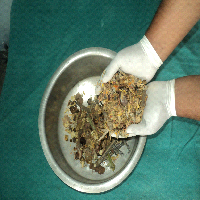
Cut Pieces Of Ingredients
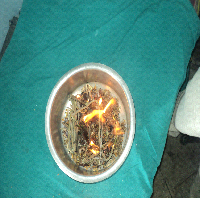
Burn Process Of Ingredients
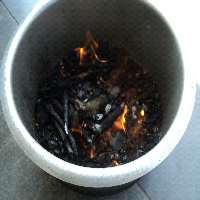
Ash after burn
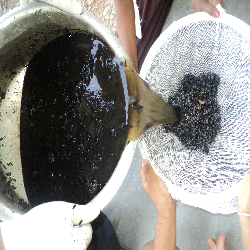
Filtration of ash
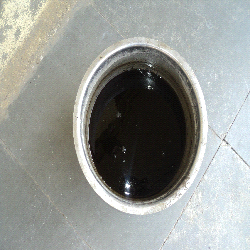
Ksharodak
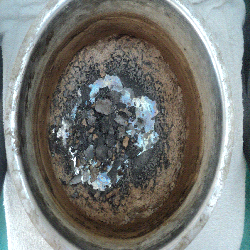
Crystals Of Mushkadi Kshara
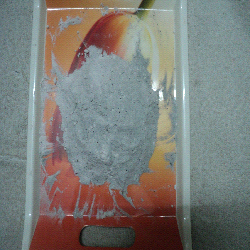
Fine Powder Of Mushkadi Kshara
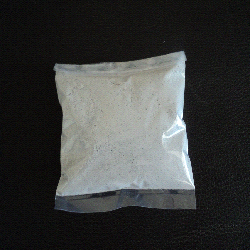
Packing Of Mushkadi Kshara
